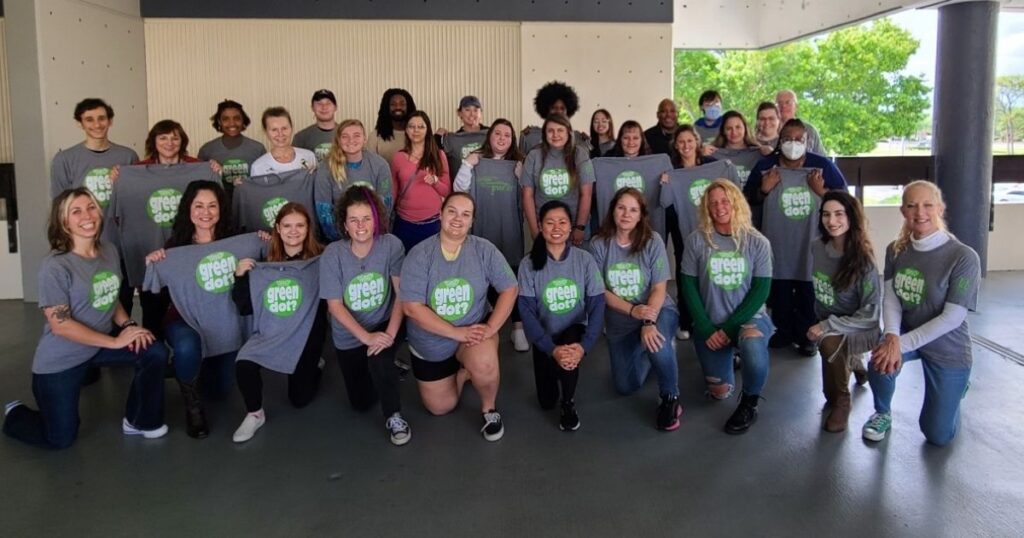What’s the deal with all those green dots on campus? And what does “Green Dot Certified” mean? The Splash Blog sat down with Dr. Barbara Kennedy (Dean of Students), Rhonda Morelock (Student Life Coordinator), and “AJ” Alexander Tanz (SGA Student Ambassador) to shed light on the mystery of Green Dot—and why every student at EFSC needs to get involved with it!
Learn more about Green Dot and register for upcoming trainings on the EFSC website.
Introduce Yourself! How Are You Connected to Green Dot?
Dr. Barbara Kennedy: I am the Dean of Students and the Green Dot Liaison. I’ve been with Green Dot from the beginning. Ten years ago, the Women’s Center asked if we wanted to be part of this grant to start the Green Dot Initiative at EFSC. It’s been 10 years, and we’re still doing it. I’m also a Green Dot Trainer, and enjoy co-facilitating the training for Melbourne students and for faculty- and staff-only trainings.
Rhonda Morelock: I am the Student Life Coordinator for the Melbourne campus. During my interview, I learned about Green Dot—a bystander intervention training program to increase campus safety. I’ve been involved with the training ever since. It’s a lot of fun.
“AJ” Alexander Tanz: I’m a student at EFSC and a student ambassador with SGA. I do campus tours, so the first time I heard about Green Dot was when I was doing the tour, and someone asked about it. After the tour, I asked Rhonda what it was and said that I wanted to do the training.
In Your Own Words, What Is Green Dot?
Dr. Barbara Kennedy: Green Dot Bystander Training teaches us how to prevent power-based personal violence in our college community. Its goal is to create a culture of people who want to care for others and make sure we’re all safe.
Rhonda Morelock: Green Dot is a training program that puts the onus on those who witness bad behaviors and is, very simply, “see something say something.” It creates an environment that shows people that violence is not tolerated.
“AJ” Alexander Tanz: Green Dot is a training to help students be more proactive in making our campus safer.
What Does It Mean To Be Green Dot Certified?
Dr. Barbara Kennedy: It means that I have been trained to know my options in situations where I feel like something unsafe is happening. Green Dot gives me the tools that I need to intervene in a way that is comfortable for me.
Rhonda Morelock: My favorite part about Green Dot is the answer to this question. Green Dot gives you tools to still do something, even if you’re not able to directly intervene, if you’re not able to say something right now, or if you are in a position where you need to report someone who has authority over you. Before Green Dot, maybe you wouldn’t have known how to do that. Green Dot helps you know what you can do without putting yourself in a personally uncomfortable or physically dangerous situation.
“AJ” Alexander Tanz: For me, it means that you went through the training and found other ways to intervene in a situation instead of just directly saying something. It gives you other ways to jump into an uncomfortable situation.
How Has Green Dot Changed EFSC Campus Life and Beyond? Do You Have Any Specific Stories You Can Share?
Dr. Barbara Kennedy: Green Dot creates a culture shift towards helping everyone as a community. Years ago, there was an altercation between two students in the quad area on the Melbourne campus. I ran out there, and I mean, they were fighting. People were taking pictures on their phones of these students fighting. But then, all of a sudden, I see five SGA students coming out in a group to intervene. One person got Security; the other person went to help the students who were fighting. All these students had gone to the Green Dot training, and I thought, “This is exactly what it’s all about.” It was just awesome. And then, afterward, one of the students looked at me and said, “That was a Green Dot!”
Rhonda Morelock: I feel proud every time I do a Green Dot training and see how many different types of students are there. I’ve never had a training session where people didn’t talk. There’s a part where people share stories anonymously. They write them down, and then you see how many people have been impacted by violence or aggression. You realize these people are here because they care and want to make a difference. This past week, a student came by my office looking for Green Dot stickers and bracelets, wanting to promote Green Dot and give some items to her friend.
“AJ” Alexander Tanz: There was a situation between two students where one made the other feel uncomfortable. Before the Green Dot training, I probably wouldn’t have said anything, thinking, “It’s not my place.” However, after the training, I realized I didn’t have to directly intervene. Instead, I could go to someone they look up to (a teacher, club sponsor, etc.) and have them talk to the students.

How Has Learning Green Dot Techniques Changed the Way You Think about Intervention?
Dr. Barbara Kennedy: Green Dot doesn’t mean putting yourself in a dangerous situation. It’s the exact opposite of that. We talk about the three D’s: distract, delegate, and direct. Some people, like me, are comfortable with “direct”—having a direct conversation or confrontation. But my daughter would not do that in a million years. She might “delegate”—come to me or someone else in authority and say, “Hey, can you go check out the situation? Because I’m not comfortable with it.” An example of “distract” would be if someone was coming on too strong, and you said, “Hey, your car is being towed in the parking lot!” and then having that person leave you to check it out. Green Dot training gives you all kinds of options. It changes the way that people think about intervening in a situation overall.
Rhonda Morelock: I have had two Green Dot situations in the community. One was coming to work, and the other was leaving work. I saw somebody passed out on the side of the road. Although I didn’t feel safe parking my car and getting on the side of the road to check on them because they were large men, I also couldn’t just pass by, so I called the police. I would have always wondered, “What if he was in trouble and I could have helped him?” Two or three years ago, I might have said, “Oh, well, maybe somebody else already called 911.” But after doing Green Dot, I’m like, “Well, what if they didn’t?”
“AJ” Alexander Tanz: Usually, I’m the type of person that would have no problem going up to somebody and telling them how it is, but when it comes to someone close to me, that can get a little tricky. They might say, “Why are you judging me like this?” Learning that there are other things that you can do to still help them without directly confronting them helped me in that specific situation.
What if I’m Shy or Have Had Bad Experiences With Confrontation, so It Makes Me Uncomfortable? Is Green Dot Still Going To Be Useful to Me?
Dr. Barbara Kennedy: Part of the training is showing students where they can go and who they can talk to when it’s difficult for them to intervene. We share all the different departments with them, like the Dean’s Office, Student Life, Security, the Ombudsman, and Title IX. These are people who help resolve the situation. It’s part of the training to tell students where to go at the college to get help.
Rhonda Morelock: And it can be fully anonymous. If a student sees something going on, perhaps with their best friend, they can report it to Security, and that friend doesn’t even have to know it was you. That’s what I really like about Green Dot: It shows you that no matter who you are or what your connection to the problematic behavior is, you can do something.
One of the Taglines of Green Dot Is “Nobody Has To Do Everything, but Everybody Has To Do Something.” What Does This Mean?
Dr. Barbara Kennedy: There’s not only one way to help. For example, there are proactive versus reactive “green dots.” A proactive green dot is wearing a Green Dot shirt, using a Green Dot pen, or writing about Green Dot on your social media. It’s all about getting the word out about Green Dot. Reactive “green dots” are when you use the Green Dot model to intervene in situations. The motto ultimately means that if you come to this training, whoever you are, there’s something that you can do that’s comfortable for you to help this culture shift of keeping everyone safe.
Rhonda Morelock: You can’t do everything. You can’t be scouting out every case of bullying and discrimination. But you can see one thing and report that. It’s about maximizing our efforts. It can be as simple as wearing a Green Dot T-shirt or just speaking positively and genuinely against issues of bullying, violence, and discrimination.
“AJ” Alexander Tanz: If everyone’s doing something, it makes our campus and community much safer.
What Should Students Expect During Green Dot Training?
Dr. Barbara Kennedy: It’s typically a 4-6 hour training. It’s a lot of fun. It’s very interactive. There are “ups and downs” in the training. It’s specifically designed to have heavy moments and then light moments. No one has to share anything if they don’t want to, but there are times when you can. Sometimes people shy away from Green Dot because they’re afraid that they’ll have to “tell their story” or be put on the spot. No one is put on the spot! You’ll be surprised by some things you learn in the training. And you get dinner or lunch, depending on the time of day, as well as prizes. I’ve been doing the training for 10 years, and there has never been a training where I had that feeling of, “Nobody’s saying anything!” So, to sum up, expect a good time and a lot of information.
Rhonda Morelock: We have little competitions. We give out poker chips to the winners and the winning teams. There are different opportunities to answer questions, and the participants get really into it. I give out chips like candy. If a team at a table is active and engaged, they get more chips. Green Dot has this back-and-forth conversational aspect. It’s not a “lecture.” That’s what I like about Green Dot.
“AJ” Alexander Tanz: I really thought it was going to be a 6-hour lecture, where you sit there and listen to a presentation and you get bored about 15 minutes into it, but it’s completely the opposite. We played so many games. In one of our games, they put the three “D’s” (Direct, Delegate, Distract) in the corner. Then, the facilitator gave us different situations, and we would walk to the corners where we felt most comfortable handling the situation. And then we explained why we were more comfortable in that situation. We got up, were moving around, and getting competitive with winning the poker chips. I wouldn’t raise my hand at first, but the games and scenarios made me want to answer the questions. It makes everyone feel like it’s a safe space where they can share their personal stories.

How Can Students Get Involved With Green Dot?
Dr. Barbara Kennedy: Once students have completed Green Dot training, we want them to encourage their friends and classmates to take the training. Spreading the word is getting involved. We also have had students who help with the training—not teaching, but setting up, handing out chips, assisting with the games, etc. We encourage students to share Green Dot wherever they are—high school, church, their community—with anyone they can.
Rhonda Morelock: You can ask for Green Dot memorabilia (like stickers) and place them on your laptops, backpacks, or notebooks. It helps advertise and get people curious. On Spirit Day, the staff and faculty can also wear their Green Dot shirt to help promote the initiative.
“AJ” Alexander Tanz: After the training, everyone gets a free T-shirt. Who doesn’t love free swag? So, wear your Green Dot shirt, and if people ask you what it is, tell them about it. Make sure they understand it’s not going to be a 6-hour, boring lecture!
What Is the Most Rewarding Thing About Being Involved With Green Dot?
Dr. Barbara Kennedy: I have a story about why Green Dot is so rewarding. Several years ago, we trained IT staff, and there were about 25 people. One week later, I walked into the library, and I saw all of the computers had Green Dot as their screen saver. IT did that without us asking. They made the Green Dot screen saver universal across all the campuses’ computers. The whole point of Green Dot is to make it mysterious—so that people feel the need to know what it is and ask about it. Then you tell the story. That was a defining moment for me. I realized, “Wow, this is really spreading just based on one training!”
Rhonda Morelock: There is always somebody in the training who doesn’t want to be there. Sometimes they are there because of extra credit, for example. But within the first 30 minutes, you’re making them laugh, and they are sharing ideas, and want to be the first to raise their hand. That’s always my favorite part. At the end of the training, one student told us she didn’t want to come, but after completing the training, she really enjoyed herself. She said, “You guys have opened my eyes to this being a good thing.” That’s all we want to do. That’s all we’re here for.
“AJ” Alexander Tanz: The most rewarding thing for me was during Green Dot training, when everyone wrote down personal stories. They read a couple out loud, and it was just enlightening to hear that there are a lot more people than you would think who have been through situations where someone could have stepped up and helped them, and no one did. It makes you realize you’re not alone, and you can make a difference.




